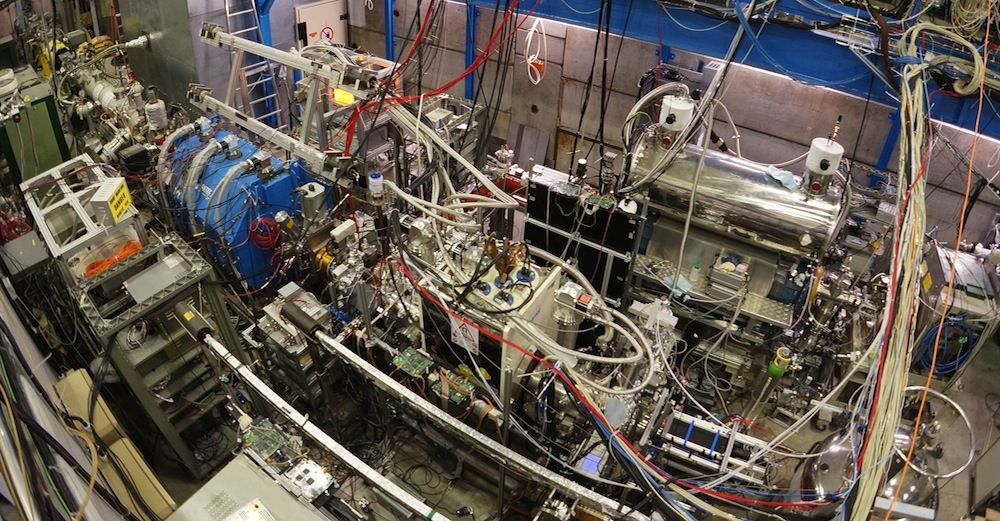Mystery Deepens: Matter and Antimatter Are Mirror Images

Matter and antimatter appear to be perfect mirror images of each other as far as anyone can see, scientists have discovered with unprecedented precision, foiling hope of solving the mystery as to why there is far more matter than antimatter in the universe.
Everyday matter is made up of protons, neutrons or electrons. These particles have counterparts known as antiparticles — antiprotons, antineutrons and positrons, respectively — that have the same mass but the opposite electric charge. (Although neutrons and antineutrons are both neutrally charged, they are each made of particles known as quarks that possess fractional electrical charges, and the charges of these quarks are equal and opposite to one another in neutrons and antineutrons.)
The known universe is composed of everyday matter. The profound mystery is, why the universe is not made up of equal parts antimatter, since the Big Bang that is thought to have created the universe 13.7 billion years ago produced equal amounts of both. And if matter and antimatter appear to be mirror images of each other in every respect save their electrical charge, there might not be much any of either type of matter left — matter and antimatter annihilate when they encounter each other. [The 9 Biggest Unsolved Mysteries in Physics]
Checking charge parity
Theoretical physicists suspect that the extraordinary contrast between the amounts of matter and antimatter in the universe, technically known as baryon asymmetry, may be due to some difference between the properties of matter and antimatter, formally known as a charge-parity, or CP symmetry violation. However, all the known effects that lead to violations of CP symmetry fail to explain the vast preponderance of matter over antimatter.
Potential explanations behind this mystery could lie in differences in the properties of matter and antimatter — for instance, perhaps antiprotons decay faster than protons. If any such difference is found, however slight, "this will of course lead to dramatic consequences for our contemporary understanding of the fundamental laws of physics," study lead author Stefan Ulmer, a particle physicist at Japan's Institute of Physical and Chemical Research (RIKEN), told Live Science.
In the most stringent test yet of differences between protons and antiprotons, scientists investigated the ratio of electric charge to mass in about 6,500 pairs of these particles over a 35-day period. To keep antimatter and matter from coming into contact, the researchers trapped protons and antiprotons in magnetic fields. Then they measured how these particles moved in a cyclical manner in those fields, a characteristic known as their cyclotron frequency, which is proportional to both the charge-to-mass ratio of those particles and the strength of the magnetic field.
(Technically, the researchers did not use simple protons in the experiments, but negative hydrogen ions, which each consist of a proton surrounded by two electrons. This was done to simplify the experiments — antiprotons and negative hydrogen ions are both negatively charged, and so respond the same way to magnetic fields. The scientists could easily account for the effects these electrons had during the experiments.)
Get the Space.com Newsletter
Breaking space news, the latest updates on rocket launches, skywatching events and more!
Perfect mirror images
The scientists found the charge-to-mass ratio of protons and antiprotons "is identical to within just 69 parts per trillion," Ulmer said in a statement. This measurement is four times better than previous measurements of this ratio.
In addition, the researchers also discovered that the charge-to-mass ratios they measured do not vary by more than 720 parts per trillion per day, as Earth rotates on its axis and travels around the sun. This suggests that protons and antiprotons behave the same way over time as they zip through space at the same velocity, meaning they do not violate what is known as charge-parity-time, or CPT symmetry.
CPT symmetry is a key component of the Standard Model of particle physics, the best description to date of how the elementary particles making up the universe behave. No known violations of CPT symmetry exist. "Any detected CPT violation will have huge impact on our understanding of nature," Ulmer said. [8 Ways You Can See Einstein's Theory of Relativity in Real Life]
Furthermore, these charge-to-mass ratios did not differ by more than 870 parts per billion in Earth's gravitational field. This means the weak equivalence principle, which holds that all matter falls at the same rate in the same gravitational field, also holds at this level of accuracy. The weak equivalence principle is a keystone of Einstein's theory of general relativity, which among other things is the best explanation so far of how gravity works. No known violations of the weak equivalence principle exist, and any detected violations of it could lead to a revolution in science's understanding of gravity and space-time, and how both relate to matter and energy.
Using more stable magnetic fields and other approaches, the scientists plan to achieve measurements that are at least 10 times more precise than what they found so far, Ulmer said.
The scientists detailed their latest findings online Aug. 13 in the journal Nature.
Follow us @livescience, Facebook & Google+. Original article on Live Science.
Join our Space Forums to keep talking space on the latest missions, night sky and more! And if you have a news tip, correction or comment, let us know at: community@space.com.

Charles Q. Choi is a contributing writer for Space.com and Live Science. He covers all things human origins and astronomy as well as physics, animals and general science topics. Charles has a Master of Arts degree from the University of Missouri-Columbia, School of Journalism and a Bachelor of Arts degree from the University of South Florida. Charles has visited every continent on Earth, drinking rancid yak butter tea in Lhasa, snorkeling with sea lions in the Galapagos and even climbing an iceberg in Antarctica. Visit him at http://www.sciwriter.us












